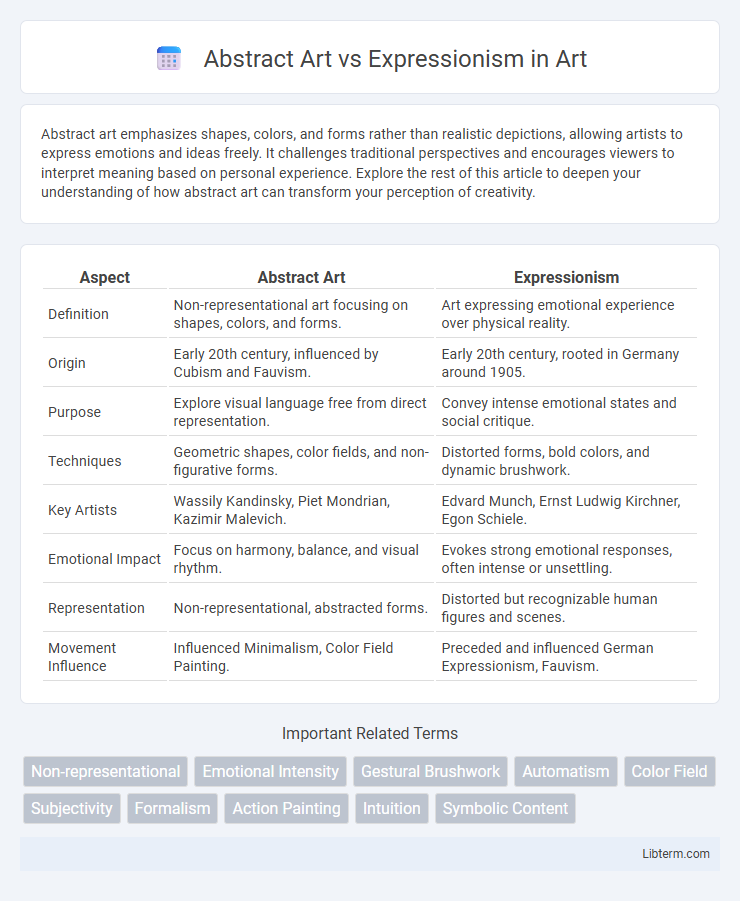Abstract art emphasizes shapes, colors, and forms rather than realistic depictions, allowing artists to express emotions and ideas freely. It challenges traditional perspectives and encourages viewers to interpret meaning based on personal experience. Explore the rest of this article to deepen your understanding of how abstract art can transform your perception of creativity.
Table of Comparison
| Aspect | Abstract Art | Expressionism |
|---|---|---|
| Definition | Non-representational art focusing on shapes, colors, and forms. | Art expressing emotional experience over physical reality. |
| Origin | Early 20th century, influenced by Cubism and Fauvism. | Early 20th century, rooted in Germany around 1905. |
| Purpose | Explore visual language free from direct representation. | Convey intense emotional states and social critique. |
| Techniques | Geometric shapes, color fields, and non-figurative forms. | Distorted forms, bold colors, and dynamic brushwork. |
| Key Artists | Wassily Kandinsky, Piet Mondrian, Kazimir Malevich. | Edvard Munch, Ernst Ludwig Kirchner, Egon Schiele. |
| Emotional Impact | Focus on harmony, balance, and visual rhythm. | Evokes strong emotional responses, often intense or unsettling. |
| Representation | Non-representational, abstracted forms. | Distorted but recognizable human figures and scenes. |
| Movement Influence | Influenced Minimalism, Color Field Painting. | Preceded and influenced German Expressionism, Fauvism. |
Introduction to Abstract Art and Expressionism
Abstract Art emphasizes non-representational forms, focusing on shapes, colors, and lines to convey meaning without depicting real-world objects. Expressionism centers on portraying emotional experiences, often through distorted forms and vivid colors to evoke strong feelings. Both movements revolutionized 20th-century art by prioritizing subjective interpretation over realistic representation.
Historical Origins and Development
Abstract Art originated in the early 20th century with pioneers such as Wassily Kandinsky who aimed to break away from representational forms to focus on color, shape, and composition. Expressionism emerged slightly earlier in the late 19th and early 20th centuries, with artists like Edvard Munch and Egon Schiele emphasizing emotional experience and subjective perspective through distorted forms and vivid colors. Both movements evolved through interactions with social and political upheavals of their times, influencing modern art's trajectory by challenging traditional aesthetics.
Key Characteristics of Abstract Art
Abstract Art emphasizes non-representational forms, relying on shapes, colors, and lines to convey meaning rather than depicting real-world objects. It prioritizes visual language that evokes emotion through composition and abstraction, often rejecting traditional perspective and recognizable subjects. This style highlights artistic freedom, encouraging viewers to interpret the work through personal perception rather than explicit narrative.
Defining Features of Expressionism
Expressionism is defined by its emphasis on emotional experience rather than physical reality, using distorted forms, vivid colors, and exaggerated lines to evoke subjective feelings. Unlike Abstract Art, which often removes recognizable subjects to focus on shapes and colors, Expressionism aims to convey intense emotional states and social critique through representational, yet highly stylized imagery. Prominent Expressionist artists such as Edvard Munch and Ernst Ludwig Kirchner highlight psychological depth and personal angst through dynamic, emotive brushwork and symbolic content.
Influential Artists in Abstract Art
Wassily Kandinsky, widely regarded as a pioneer of abstract art, emphasized the spiritual and emotional power of pure color and form, shaping the movement's direction. Piet Mondrian introduced geometric abstraction through his iconic grid compositions, influencing modern design and abstraction principles. Kazimir Malevich's Suprematism broke away from representational art, focusing on basic shapes and limited color palettes to explore pure artistic feeling.
Notable Figures in Expressionism
Notable figures in Expressionism include Edvard Munch, whose iconic work "The Scream" epitomizes emotional intensity and psychological depth, and Egon Schiele, known for his raw, provocative portrayals and distinctive line work. Wassily Kandinsky, often associated with both Abstract Art and Expressionism, bridged the styles by emphasizing color and form to evoke inner emotional experiences. Ernst Ludwig Kirchner contributed significantly to German Expressionism with his vivid, angular depictions of urban life, reflecting the movement's focus on subjective perception and emotional response.
Techniques and Mediums Used
Abstract art employs techniques such as geometric shapes, bold color fields, and non-representational forms, often utilizing mediums like acrylics, oils, and mixed media on canvas or paper to emphasize form and color over recognizable subjects. Expressionism centers on conveying emotional experience through distorted figures, exaggerated brushstrokes, and intense hues, frequently using oil paints on canvas to highlight psychological depth and raw emotion. Both movements experiment with texture and layering techniques but diverge in purpose: abstract art prioritizes conceptual interpretation, while expressionism aims for visceral emotional impact.
Emotional Impact and Audience Perception
Abstract Art emphasizes non-representational forms and colors to evoke subjective emotional responses, often leaving interpretation open to the audience's imagination. Expressionism centers on conveying intense emotions and personal experiences through distorted forms and vivid colors, aiming to create a direct emotional connection with viewers. The emotional impact in Abstract Art relies on individual perception, while Expressionism seeks to communicate shared feelings more explicitly.
Major Differences Between Abstract Art and Expressionism
Abstract art emphasizes non-representational forms, focusing on color, shape, and line to evoke emotions without depicting real-world objects. Expressionism, however, centers on representing emotional experiences and subjective perspectives through distorted forms and vivid colors. The major difference lies in abstraction's detachment from reality versus Expressionism's intent to communicate inner feelings and human conditions.
Lasting Influence on Modern Art
Abstract Art revolutionized visual language by emphasizing color, form, and line without representing objects, profoundly shaping modern art's move toward non-representational aesthetics. Expressionism prioritized emotional experience and subjective perspective, influencing the dynamic intensity and psychological depth common in contemporary artworks. Both movements contributed enduring principles that continue to inform modern art's exploration of abstraction and emotional expression.
Abstract Art Infographic

 libterm.com
libterm.com